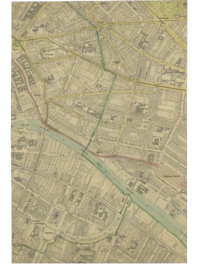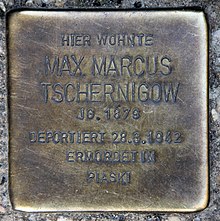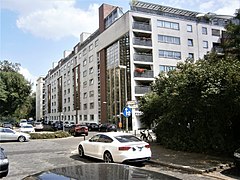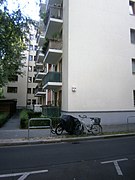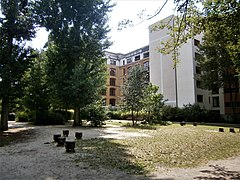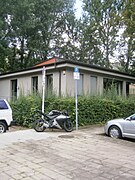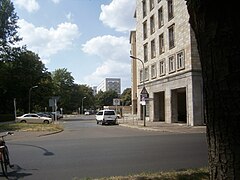Blumenstrasse (Berlin-Friedrichshain)
| Flower Street | |
|---|---|
| Street in Berlin | |
| Flower Street | |
| Basic data | |
| place | Berlin |
| District | Friedrichshain |
| Created | 18th century |
| Newly designed | around 1953 |
| Hist. Names | Lehmgasse |
| Connecting roads | New flower street |
| Cross streets | Krautstrasse Andreasstrasse |
| use | |
| User groups | Pedestrian traffic , residents |
| Technical specifications | |
| Street length | 210 meters |
The flowers street located in the district Friedrichshain of Berlin district of Friedrichshain-Kreuzberg . Until 1816 it was called Lehmgasse . It was originally located between Alexanderstraße in Mitte and Andreasstraße . It was named after the gardens of Jean David Bouché (1747–1819) , located on the street . Due to the new development south of Karl-Marx-Allee (then Stalinallee), the street of Blumenstraße between Krautstraße and Alexanderstraße was built over and abolished until 1970. August 1963 was named Neue Blumenstrasse .
Location and overview
Location and statistics
The Blumenstrasse lies between Krautstrasse and Andreasstrasse , it has the street number 44676, a length of 212 meters and is level. According to the structure of the living-world-oriented rooms, its entire length belongs to the forecast area Friedrichshain West, the district region Karl-Marx-Allee Süd and the planning area Andreasviertel. As a street in the regional reference system, it is noted as “other streets”. The postcode is 10243. There are house numbers 38 to 49, which are counted consecutively , as was the case with the buildings in the 18th and 19th centuries. Century was common. It began on Alexanderstraße with house number 1 and further on the right (southern) side to 49 and after changing sides to the north side to 101 (102) back. These (northern) properties up to Krautstraße are built over with the block of flats on Karl-Marx-Allee.
Change after 1945
Because of the destruction of the district on and around Blumenstrasse by bombing and in 1945 during the storming of Berlin, the western part from Krautstrasse to house numbers 1 and 101 on Alexander- opposite Schicklerstrasse ( old west end ) was lifted and built over. In the west to east direction it had the side streets in the Mitte district until then: Wallnertheaterstrasse (south), Schillingstrasse (north), Ifflandstrasse and Grüner (1935–1945 Brauner ) Weg (south side), Markusstrasse (crossing). The rest of the run belonged to the Friedrichshain administrative district with the Krautstrasse intersection and the end of Andreasstrasse.
After the Second World War , the new Berlin center was planned for the city center in the east - for Friedrichshain ( Stalinallee ) - with a complete redesign of the streets. The 1,015 meter long Blumenstrasse lost 800 m and was gradually abolished by the end of the 1960s. The new street was a straight continuation in the Mitte district named as Neue Blumenstrasse .
The old course
The (historical) Blumenstrasse was part of the Stralau district. The plots were counted continuously , starting from Alexanderstraße on the southern side of the street with plot 1. It was in the police station 22, organizationally the plots 1, 2, 4-26 and 59-84 belonged to the district 103 (Alexanderstraßen district), the house 3 to 102 (Holzmarkt district), in the middle section were 27-34 and 51a -58 in district 104 (Blumenstrasse district) and 34a to 51 belonged to 119 (Nicolaus Hospital district). The parishes were assigned to the southern houses 1–14a parish Ⅰ (St. Andreas Church, Stralauer Platz), the eastern houses to parish XVI (St. Marcus Church, Weberstrasse 54/55) and the northern houses 76–84 parish Ⅷ (St. Jacobi Church, Oranienstrasse 133). In 1850 the Blumenstrasse with the 109 plots (large ones were divided, some combined) is largely built on: there are 23 apartment buildings with more than 10 tenants, 23 houses occupied by the owner and the construction site numbers 1, 7/8, 25, 33, 41, 43–45, 49, 51, 52, 55/56. 20 years later, Wallnertheaterstraße was added between 1 and 3, plot 2 for the breakthrough, Rosengasse was called Markusstraße . Lot 40/41 became Andreasstraße 48 and road land. Plots are newly built: 9 and 9a are under renovation in 1870, 49 is still and 11 and 79 were construction sites. More than 10 tenants now live in 42 houses (servants, assistants and house servants are not recorded in the address book). Note: the easternmost plots 40 and 41 (already on Lehmgasse) were on the passage to Grosse Frankfurter Strasse. They were lifted around 1860 in order to create a north-south connection when the Andreasstrasse was expanded from Andreasplatz to Große Frankfurter Strasse.
In 1913 (resolution passed in 1912) the plots of land on Blumenstrasse were rearranged, house 1 was still on Alexanderstrasse, but the counting ended opposite with plot 102 (previously 84), which belongs to Alexanderstrasse 24. Shared lots (like 51, 51a, 51b, 51c) have now been counted. At this point in time, there was a noticeable number of tenement houses owned by heirs or pensioners. The address book 1912 (with the status of 1911) still shows the northern corner lot Alexanderstraße as 84, on Andreasstraße the counting changed from 39 to 42 on the north side.
The houses at Blumenstrasse 22–26 (south) and 77–79 (north), some of which were preserved during the destruction in the war, and a few other still habitable ruin houses were finally cleared for new buildings by 1970. Almost 40 meters of the old Blumenstraße in front of the residential building Singerstraße 1 have been preserved. This residential building had the address Blumenstraße 11 and survived ruins and new buildings. The remainder is located opposite the confluence of Neue Blumenstrasse on Singerstrasse, 30 meters to the street corner with Grüner Weg (since 1947 Singerstrasse) and Ifflandstrasse, houses 12 and 13 on the street corner were war ruins. This remainder of the road and building was incorporated into Singerstrasse with a change in address. In fact, the southern corner house number 49 on Andreasstrasse was preserved in the structure of 1890. It has been expanded and renovated. It should be noted that the opposite "Stalinallee-Bau" ( Andreasstrasse 46) was one of the first residential buildings on Stalinallee-Süd in 1953. The course of the Blumenstrasse is visibly marked on the “Plansche Singerstrasse”. The trapezoidal pool lies on Singerstrasse and is sloping to the north. The sidewalk in the row of trees on the northern edge of the Plansche (on the southern edge of the former nursery site Neue Blumenstraße 5) is in the Blumenstraßen-Lauf, at that time the tenement houses 15-18 and 86-82 were near the confluent Marsiliusstraße .
history
“Since the middle of the 18th century there were several large gardens not far from the Jannowitzbrücke , on the north side of Holzmarktstrasse . [... They] turned into a multitude of small, very popular coffee restaurants. As Berlin grew, these gardens were soon cut through by streets, and one of these streets is the Blumenstrasse. However, it did not use this name until it was "advanced". By royal cabinet order of August 17, 1816, it, which was formerly called "Lehmgasse", was given the name "Blumenstrasse" at the request of the residents. […] She owes this promotion to the gardener family Bouché, mentioned as early as 1799 , whose famous flower garden even visited the more elegant Berlin to drink coffee in the greenhouses under green and flowering plants in winter too. "( Regina Mangold : )
The Lehmgasse was used as a street with the arrival of the Huguenots , before the gates of the city it was probably laid out as a path to the Frankfurter Chaussee or into the gardens and fields. In the directory from 1801 (new descriptive tables from the entire residential city of Berlin, or evidence of all owners) the Lehm-Gasse is listed with a length of 350 rods or 1750 steps . Property 70 across from Der Grüne Weg belonged to the gardener Paul Bouché: the driveway and side of the greenhouse, along with the garden fence, belonged to # 67. The directory from 1844 shows the location by streets and their inhabitants for the first time.
An eviction on July 25, 1872 in house no. 51c led to the tenants' protests, known as the Blumenstrasse riots or the uprising in the Blumenstrasse . The cause of the unrest was that two family fathers committed suicide on April 2, 1872 because of the lack of residence of their relatives.
In January 1919 the November Revolution in Berlin was followed by a spontaneous Spartacus uprising . The general strike led to street fights with barricades in the workers' districts, including around Große Frankfurter Straße and in the Stralauer / Andreasviertel . Police chief Noske had heavy weapons used against the insurgents, and houses were destroyed. House 68 (Nordosteckhaus Marsiliusstraße) was badly damaged in the process.
Residents and land
- French Protestants, the "Réfugiés", came to Prussia at the invitation of the Great Elector. The inhospitable area of the Stralau quarter with meadows and high groundwater level was chosen as an (inexpensive) settlement area, so the Bouché came to the Lehmgasse. The nearly 5,000 new citizens were not welcomed by the 20,000 Berliners. Even then there were fears of foreign infiltration by Paddenfresser (frog eaters). In 1803, 47 gardener families lived in the Köpenicker and Stralau suburbs. In 1704 the Huguenot David Bouché bought a four- acre property on Lehmgasse for 1200 thalers .
- The town theater "Thalia", later Wallner Theater , was located at Blumenstrasse 9a , although the entrance was from Grüner Weg. In 1790 the "Thalia" was built here as the house of the Society of Friends of the Theater (still in Lehmgasse ).
- Blumenstrasse 9 with the theater building (Thalia, Wallner-Theater ) is, according to a widespread interpretation, the model for the saying “Oh you green nine!” Because the main entrance to the theater was initially from the Grüner Weg. Both streets crossed at an acute angle.
- Alfred Döblin , among others, lived in the street . When Döblin's father had left the family, his mother moved to Blumenstrasse in October 1877 and Döblin entered the third class of the 49th community school (Blumenstrasse 63a in Hinterfeld). The mother draws her income from cleaning work and subletting. In 1897 the father temporarily moved back to the family, which now lived at Grüner Weg 108.
- Heinrich Zille received his first drawing lessons on Blumenstrasse when the family lived on Kleine Andreasstrasse .
- The Berlin composer Hugo Kaun, after whom Kaunstraße is named, was born on March 21, 1863 in house no. Kaun's father, owner of a weaving shop, was tenant in the house at Blumenstrasse 34a in 1863 and in Blumenstrasse 34 from 1864.
- On the ground floor of the five-storey residential building at Blumenstrasse 69 (Nordwesteckhaus Marsiliusstrasse) with entrance Ⅱ on Marseliusstrasse, there was a Besohl establishment and a metal goods store. The house, damaged in the air raids on Berlin, was torn down after the Second World War . The neighboring house at Blumenstrasse 70 is listed in the address book with nine entrances.
- The cinema "Residenz-Lichtspiele", from 1931 Resi-Tonfilmbühne, stood at Blumenstrasse 9 and was destroyed in air raids in 1943. It was set up in the former splendid halls of “Alt-Berlin” (Blumenstrasse 10).
- From 1908 to 1939 Paul Baatz's "Resi-Casino" was located in the house at Blumenstrasse 10. The name always referred to the Residenz Theater . Blumenstrasse 9 and 10 were, according to today's address, west of Singerstrasse 1 and in front of Ifflandstrasse 2, 3. The Resi-Palast offered 1000 visitors and the floor of the dance hall was made of reflective glass, there were also four bars and a pneumatic tube with 135 drop-off points. There were 200 desk phones and the lighting in the late 1920s had 86,000 incandescent bulbs. This establishment came to life after 1945 in Charlottenburg, and was used intensively by the US soldiers of the Berlin garrison.
- The following deportations from 1943–1945 from Blumenstrasse are listed in the Book of Memories . House 13: Herta Dobrin (born Rosenthal, July 26, 1903), Fritz Julius Dobrin (June 26, 1907). House 25: Walter Michelsohn (December 23, 1910 * LL: July 17, 1943 in Riga), Hildegard Michelsohn (née Schirn, June 27, 1909). House 41: Johanna Boetzel (born Peritz, December 4, 1884) Martin Boetzel (May 14, 1880). House 80: Regina Bass (born Prager, May 1, 1878). House 74: Selma Bock (born Rosenthal, September 28, 1891), James-Hugo Bock (May 9, 1926). House 94: Eva Jaeckel (born Lippmann, July 28, 1885), Alfred Jaeckel (September 23, 1880). House 98: Jachet-Chaja Heller (born Steiner, December 28, 1888), Erna Heller (March 16, 1906), Josef-Gerhard Heymann (December 25, 1897, from Stuttenhof to Buchenwald on August 16, 1944).
- Stumbling blocks for deported Jews are at Blumenstrasse 49 for Max Marcus Tschernigow (December 7, 1879 in Rathenow, deportation from Berlin on March 28, 1942 to the Piaski ghetto).
- In the 1990s, the building area at the corner of Blumenstrasse and Krautstrasse was redesigned (Blumenstrasse 44, Krautstrasse 52: 1.12 ha ). The development of the plots at Blumenstrasse 38–41 was carried out in 1995–1997 as the “Krautstrasse and Blumenstrasse residential complex” on the existing street front through new construction. Along the Krautstrasse, the building fabric for the residential complex was replaced with block sections 51–53. The southeast corner of Krautstrasse and Blumenstrasse was rebuilt as social housing with 150 residential units, a commercial unit and 77 underground parking spaces on six floors for 25 mullion euros (“modern interpretation of a Berlin perforated facade”). From 2015, the residential complex was taken over by Gewobag . The new building required the replacement of the six individual buildings from the 1950s along the 110 meter street front.
- The buildings in the depths of Krautstraße 52 along the school border (flower school) were created and preserved in their structural fabric between 1900 and 1918. These old industrial buildings were renovated between 2000 and 2010 and converted into residential buildings as Blumenstrasse 42–46. In some cases, commercial buildings were used to create living spaces and lofts. The building (Krautstrasse) 51a dates from the 1970s. The two houses at Blumenstrasse 47 / 47a were rebuilt in the mid-25010s. For example, the Blumenstrasse 45 playground was given a new location on the area north of the flower school, occupying the Blumenstrasse 48 property and being used by the “Blumenkinder” daycare center (behind Andreasstrasse 49).
Blumenstrasse building
New flower street
location
In the Mitte district, as part of the planning in the eastern center, a changed street layout - called Neze Blumenstraße - was created. The name Blumenstrasse was associated with the revolutionary traditions of the labor movement and should be retained in the changed street layout. A right-angled street was laid out, which supplemented this name reference with the prefix New to the eastern piece of Blumenstraße from Krautstraße almost straight, ( east ), parallel to Stalinallee (513 m). A road branch kinking to the south (240 m) was drawn as the end point to the (exposed) Blumenstrasse at the corner of Ifflandstrasse and Grüner Weg (from 1947 Singerstrasse). Ultimately, the street was rebuilt during the construction south of Stalinallee between 1958 and 1963. The connection via Jacobystraße to Schillingstraße was given the same name, with the proximity of the dominant Stalinallee development, this is a footpath south of the (former) Café Moskau .
Land
The Neue Blumenstraße is listed under 42061 in the street list and is, according to its function, a category V access street. The numbering for this street was based on a continuous counting, in keeping with the spirit of the times, the blocks of houses around the street are no longer required. Addressed to the street, the built-up plots from Singerstraße to the north belong to the Mitte district: to the east of the street, apartment blocks 1–4, 6–10 and 14–18, as well as building 4a (transformer station 3, Vattenfall), 22 (built as a kindergarten, Now used by Kinderhaus Mitte e.V.) and 5 (built as a day nursery, now used as a Buddhist mediation center with Café Lotos ). The 11-13 apartment block is on the western side of the street. To the south of the section parallel to Karl-Marx-Allee are the transverse blocks 19–21 and the flat office building (23 /) 24. The district border middle / Friedrichshain-Kreuzberg was placed around the southern houses at Strausberger Platz 12-14 and 15-19 (based on the former street of Markusstraße). As a result, there are 240 m of street running in the Friedrichshain district to the east, without any addressed buildings, to and across Lichtenberger to Krautstraße. The northern apartment blocks on the street are each addressed to Strausberger Platz and Karl-Marx-Allee, so there are no addresses on Neue Blumenstrasse in the Friedrichshain district. The (numbered) buildings on Neue Blumenstrasse form the statistical block 105018 and belong to the postal code 10179.
Construction age
The residential buildings on the north side of Neue Blumenstrasse are (like on Blumenstrasse) facing Karl-Marx-Allee (buildings 1962/1974: 38–44, 48–52: center) and Strausberger Platz (1950s: 19–12, Friedrichshain ) addressed. The blocks of flats on Neue Blumenstrasse differ in age: Blocks 6-10, 14-18 and kindergarten (22) and crèche (standing transversely in west-east direction) were built in the 1950s along with Stalinallee. Just like the three south on the west side (to Schillingstrasse), which were addressed as Singerstrasse 121–118, Schillingstrasse 3–6, 8–11. In contrast, the QP apartment blocks 1–4, 11–13 and, further east, the three-part block 19–21 were built at the end of the 1960s (in 1970). Administrative flat building number 24 also dates from these years. The type of construction changed over the decade from brick buildings and large blocks to prefabricated buildings.
- Addresses in the middle
- Streets in Friedrichshain
See also
Web links
- Flower Street. In: Street name lexicon of the Luisenstädtischer Bildungsverein (near Kaupert )
- Lehmgasse . In: Luise.
- Entry in the Friedrichshain Chronicle
- Blumenstrasse: OSM-ID = 37452234
- Openstreetmap: West to East for Neue Blumenstrasse
Individual evidence
- ↑ Bouché took over the gardening business from his father Pierre Bouché. Nicolai praised the “exquisitely beautiful fruits” from the “Bocher's orchard”.
- ↑ Krautstraße - Knick - Singer- / Ifflandstraße
- ^ Map of Berlin 1: 5000
- ↑ It is 35.6 m on Krautstrasse and 35.7 m on Andreasstrasse
- ↑ RBS: The Berlin variant of the small-scale structure is called the regional reference system, it is a geodatabase with the addresses, streets, blocks and reference areas of Berlin.
- ↑ Category V according to StEP, the road development plan
- ↑ Damage to the building 1945 Blue: totally destroyed, light blue: can be rebuilt, the old route of the Blumenstraße is underlaid with the street layout of the 1970s
- ↑ Blumenstrasse . In: Berliner Adreßbuch , 1943, IV., P. 79 ff. (House 1–26 and 72–101: Post District C2, Administrative District I Mitte, Tax Office Alexander // 27–71: Post District O17, Administrative District V Horst Wessel (di Friedrichshain 1936–1945), Andreas tax office).
- ↑ Map basis: Senate Department for Urban Development and the Environment, Geodata Service, State Archive Berlin, Map Department, Allg. Card collection
- ^ Building damage 1945: Blumenstrasse
- ↑ On histomapberlin.de , the map 423D / 1966 shows two more sections of the Blumenstrasse that were allocated to 423D / 1970. 1) For Friedrichshain 90 meters west of Krautstraße 2) for the middle 120 meters west of Markusstraße with houses 77–79 and 22, 25, 26.
- ↑ a b Map of Berlin 1: 5000: Current location : house numbers 38–41, 47, 47a, 49
- ↑ Proof of the city districts . In: Allgemeiner Wohnungs-Anzeiger together with address and business manual for Berlin , 1870, V., p. 83 ff.
- ↑ Blumenstrasse . In: Allgemeiner Wohnungs-Anzeiger together with address and business manual for Berlin , 1870, VI., P. 96. "Proof of streets [...] with details of police = districts, city = districts, poor = commissions and parishes".
- ↑ In the address book, parcels / land with owners registered in the cadastre are meant as construction sites. There does not have to be any construction or building will.
- ↑ Blumenstrasse 1–84 . In: Allgemeiner Wohnungsanzeiger für Berlin, Charlottenburg and Umgebung , 1850, II., Pp. 13, 14 (cross streets: 1 on Andreasstrasse, between 11 and 15 on the green way, between 27 and 28 Rosengasse, between 35b and 35 Krautsgasse // between 39 and 40 page changes // between 52 and 53 on Krautsgasse, between 57 and 58 Rosengasse, 68/69 Garten Bouché with residence and 70 properties, between 75 and 76 on Schillingsgasse, 84 on Alexanderstraße , House 84 see Alexanderstraße 21).
- ↑ Blumenstrasse . In: Berliner Adreßbuch , 1970, II., P. 29 ff.
- ↑ With the recognition of Lichtenberg as a municipality, there were changes to the area and property in the east of (old) Berlin, especially Friedrichshain.
- ↑ Blumenstrasse 1 to 102 . In: Berliner Adreßbuch , 1914, III., Pp. 85 ff. "1, ← Wallnertheaterstraße →, 2 (also Wallnertheaterstraße 22), 3–7, 8 (also Wallnertheaterstraße 16/17, Ida-Claus-Stiftung), 9 ( Ida Claus Foundation), 10 (Grand Halls “Alt-Berlin”, E: Innkeeper P. Baatz, Residenz-Lichtspiele by W. Bromme), 11–13, ← Ifflandstraße →, ← Grüner Weg →, 14/15 (also Grüner Weg 124 and 125), 16 (also Grüner Weg 123), 17–26, ← Markusstraße →, 27–32, ← Markusstraße →, 33/34 (“Markushof”, also Krautstraße 4, 5 and Markusstraße 18, 35 –37), ← Krautstraße →, 38 (also Krautstraße 53), 39–49 // ← Andreasstraße → // 50, 51 (to Große Frankfurter Straße 113), 52 (also Große Frankfurter Straße 111), 53–56, 57 (also Große Frankfurter Straße 106), 58–60, ← Krautstraße →, 61–70, 71 (also Markusstraße 22), ← Markusstraße →, 72–79 (77 owned by the City of Berlin), 80/81 (E: Ingenieur Lachmann, Workers 'Home of the Association for the Promotion of the Workers' Movement, Post Office 99), 82, 83, 84/85 (also Marsiliusstraße 12), 86 (E: City of Berlin), ← Marsilius straße →, 87, 88 (E: City of Berlin: front building and 9 staircases), 89–94, ← Schillingstraße →, 95 (E: City of Berlin), 96–101, 102 (to Alexanderstraße 24), ← Alexanderstraße → “( The majority of the houses have more than 10, many more than 30 tenants.).
- ↑ O.27 Blumenstrasse . In: Berliner Adreßbuch , 1912, III., P. 81.
- ↑ Aerial photos 1953, scale 1:22,000 , the course of the Blumenstrasse can be seen and the ruins of the war can be seen.
- ↑ Histomap.de : Straube IIA 1910 to 432D from 1993, search term Blumenstraße (10179)
- ↑ Printed matter - 0903 / V water splash in Berlin-Mitte , major inquiry in the BVV Mitte of Berlin, decision December 21, 2017]
- ↑ After the renovation in 2017 and problems with the water quality, it was in operation in July 2018. In addition: Two children's paddling is not running . In: Berliner Woche, August 2, 2013. + Where did the kids go? In: Tagesspiegel, July 5, 2016. + Water playgrounds start the season late . In: Berliner Woche, June 4, 2017.
- ↑ Singerstraße: paddling pool and green area . On: friedrichshainblog.de, May 11, 2010
- ↑ Google Earth: between 52 ° 31'1,7 N / 13 ° 25'31,3 O and 52 ° 31'1,8 N / 13 ° 25'25,7 O
- ↑ Two times "Green Nine". Berlin amateur theater of the Biedermeier period read from files. Private print 1956
- ↑ It should be noted that the Stralower Tor near the Spree already existed around 1650. To the north, the Georgentor was the next extension of Georgenstrasse. The Frankfurter Tor came later and for a loam alley it was advantageous to lay down the city wall and moat as a customs wall. Alexanderstrasse was in front of the city for communication.
- ^ Register of all streets and alleys , as well as street representations and residents: Lehm-Gasse
- ↑ The Green Way between Rosen-Gasse and Lehm-Gasse
- ↑ Members of the Bouché family in the 1818 directory
- ↑ General housing gazette for Berlin for the year 1825 : among others Bouché: art gardener D. jun. Bouché: Blumenstraße 12 // Art gardener L. Bouché: Blumenstraße 70 (owner) // Art gardener PF Bouché: Blumenstraße 11 (owner)
- ↑ Proof of each individual numbered house: Blumenstrasse, page 544 ff.
- ↑ Houses on Blumenstrasse in the general housing gazette: 1871 // 1872 // 1873
- ^ Joachim Berger: Berlin liberal & rebellious . Berlin 1987, p. 104 and Kuno Haberbusch: Documentation Berliner Linie , Berlin 1981, p. 3: “A carpenter should be put on the street by the executor. When the fire brigade came to clear away the household items, the excitement of the people overflowed. The landlord's window panes were thrown in. The mounted police were used to disperse the 4,000 to 5,000 demonstrators and were greeted with stones thrown. A street battle broke out that lasted until 3 a.m. The next morning word got around that the police had started to pull down the barracks for the homeless at Frankfurter Tor ("Barackia"). The riot spread across the entire city district and extended to Blumenstrasse, Frankfurter Strasse, Weberstrasse and their cross streets. Gas lanterns were thrown in, gutters dug and barricades were built. Two battalions of the Kaiser-Alexander-Regiment and two squadrons of Guard Dragons were ready to march out armed with live cartridges. ”According to: geschichtsverbindungen.dragonerareal.org
- ↑ The loud lament of the unfortunate - the riot of the flower streets
- ↑ City Museum Collection Inv.Nr. IV 63/1888 V . November Revolution : Destruction in Blumentstrasse. During the March fighting in 1919, manufacturer Verlag Michaelis, Berlin p.
- ↑ Blumenstrasse 68 . In: Berliner Adreßbuch , 1919, III., P. 78. “House owner: Thielesche heirs, 28 tenants”.
- ↑ Blumenstrasse 68 . In: Berliner Adreßbuch , 1920, III., P. 81. “House owner: Thielesche heirs, 27 tenants” (house 69 on the opposite corner of Marsiliusstraße also belonged to the Thielschen heirs).
- ^ Postcard Great street fighting during the Heneral strike . - Destroyed house at Blumenstrasse 68 (four floors and top floor)
- ↑ a b Successful immigrants thanks to the Great Elector . Berlin Week, February 18, 2016
- ↑ The rarely romantic flower route : “The largest flower nursery belonged to Pierre Bouché. From 1740 he invited to the hyacinth exhibition; the bulb plants bloomed here in large fields. His clay path no. 11 was a destination for the noblesse. "
- ↑ More than just theater
- ↑ The writing doctor: Alfred Döblin and his traces in the district . In: Berliner Woche , January 13, 2018
- ↑ 49th Community School . In: Berliner Adreßbuch , 1877, II., P. 38. "Property of the magistrate, administrator: Lehmann, residents: main teacher, school clerk, supervisor, a pharmacist, a tavern, a tailor and siblings A. and M. Thierry" (Couriers, servants, lodgers are not listed in the address book).
- ↑ Kaunstraße near Luise
- ↑ Jens Christian Peitzmeier: The musical artwork as patriot and enemy . Disserta-Verlag, Hamburg 2013, ISBN 978-3-95425-150-6 , limited preview in the Google book search, the composer's CV
- ↑ Blumenstrasse 69 . In: Address book for Berlin and its suburbs , 1901, III .. "House owners: Merchants E. and H. Scholz (from No. 70), 42 tenants".
- ^ Ralf Schmiedecke: Archive Pictures Friedrichshain . Sutton-Verlag, Erfurt 2006, page 47, photo around 1900, limited preview in the Google book search
- ↑ Cinema history and dates
- ^ Resi Dance Palace
- ^ Wolfgang Scheffler, Diana Schuller: Book of Remembrance - The German, Austrian and Czech Jews deported to the Baltic States . KG Saur, Munich 2003, limited preview in the Google book search
- ↑ Commemorative Book: Victims of the Persecution of Jews under the National Socialist Tyranny in Germany 1933–1945
- ^ Building age 1992/93: building area Blumenstrasse to Krautstrasse
- ↑ Histomapberlin : compare with the search word Blumenstrasse the map 423 D from 1993 or before with the current representation
- ↑ Krautstrasse residential complex, Berlin-Friedrichshain The construction was carried out by Bernhardt Schmidt (BSP) and was managed by TREUCON Real Estate GmbH, Uhlandstrasse
- ↑ Blumenstrasse / Krautstrasse 10243 Berlin Friedrichshain-Kreuzberg
- ↑ Seen across Andreasstrasse.
- ↑ New Blumenstrasse at kauperts.de
- ^ Map of Berlin: Neue Blumenstrasse
- ↑ Kinderhaus Berlin-Mitte e. V. Carrier for educational assistance
- ↑ Lotus-Vihara Buddhist Center
- ↑ FIS-Broker: building age 1992/93 spelled brown: construction period 1946–1961, light brown: construction period 1962–1974
- ↑ The houses are at Strausberger Platz
Coordinates: 52 ° 31 '3 " N , 13 ° 25' 50" E

